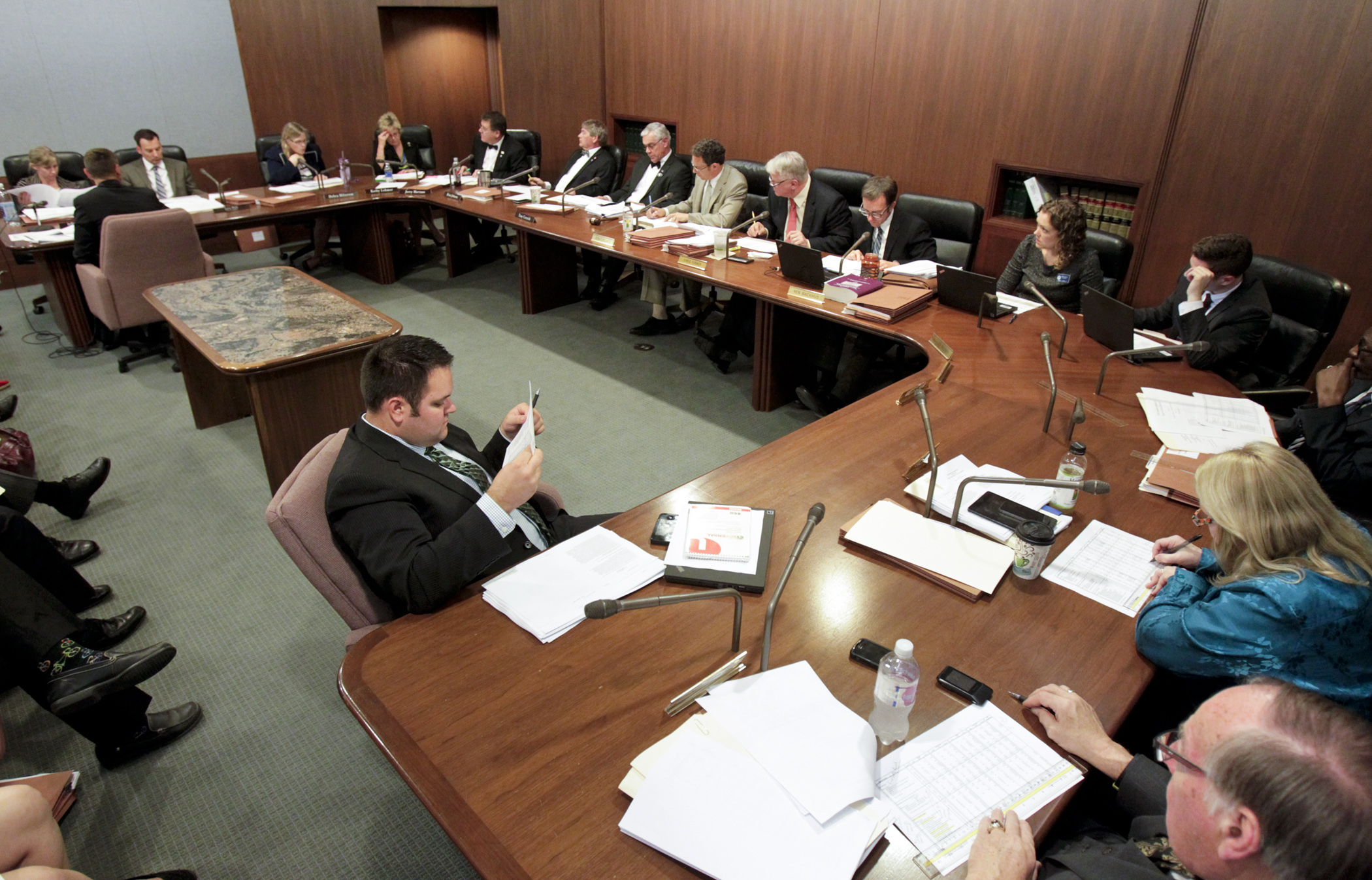Public safety/judiciary conferees start to compare funding, policy proposals

The House and Senate have decidedly different views on how to fund the state’s judicial branch and the Corrections, Human Rights and Public Safety departments for the 2016-17 biennium.
Conferees began reviewing their differences on HF849/SF878* Wednesday, but took no further action. They are scheduled to get together again Thursday.
The Senate plan, sponsored by Rep. Ron Latz (DFL-St. Louis Park), calls for total General Fund spending after adjustments of $2.12 billion, just over $35 million more than the House plan, which Rep. Tony Cornish (R-Vernon Center) sponsors.
Nearly half of the spending difference (about $16.9 million) comes in employee and judge compensation for the Supreme Court, Court of Appeals and district courts. The Senate provides a 4 percent bump each year; the House 1.5 percent.
The Senate would provide an additional $170,000 in the biennium for a third law clerk for the tax court, while the House would spend an additional $100,000 on specialty courts.
In addition, the Senate would spend $3.18 million on juror compensation by doubling the daily per diem rate from $10 to $20 and increasing mileage reimbursement from 27 cents to 56 cents per mile.
Within the Department of Public Safety, the House spends an additional $1.5 million in General Fund dollars on a disaster contingency account in Fiscal Year 2016 ($2.5 million vs. $1 million) and $238,000 more for a digital forensics unit at the Bureau of Criminal Apprehension ($1.83 million vs. $1.6 million).
The Senate spends $2.73 million more for Office of Justice programs, including the following increases:
- $800,000 for youth intervention programs; the House zero;
- $800,000 for crime victims services; the House $100,000;
- $200,000 for child advocacy centers; the House $100,000;
- $200,000 for juvenile detention alternatives; the House $100,000;
- $200,000 for a Minneapolis emergency shelter facility for East African women and child victims of domestic abuse and trafficking; the House zero; and
- $100,000 for sexual assault prevention grants; the House zero.
The House would spend an additional $100,000 — the Senate zero — on victim support for crime and suicide survivors and the House would spend $100,000, double the Senate amount, for a grant to local law enforcement for training and technology to find lost individuals wearing a special transmitter that looks like a bracelet — the so-called Project Lifesaver.
Within the Department of Corrections, the Senate would spend $4.23 million to switch kitchen workers at several facilities from contract employees to state employees; $2.2 million to fund 19 new positions to provide 24-hour nursing coverage at three additional facilities; and $1.1 million to expand offender medical services, including an electronic health records system. The House would spend an additional $1.21 million on a fugitive apprehension unit; the Senate $540,000.
Policy provision differences
Despite a threat from Gov. Mark Dayton to veto omnibus bills with policy provisions, both bills have many. [See the bill comparison summary]
Among the provisions in the House bill, but not the Senate bill:
- creation of a 15-year felony for a person convicted of criminal vehicular homicide involving impairment that occurs within 10 years of a prior qualified driving offense;
- use of a Blue Alert system to disseminate urgent information to the public to help locate an individual suspected of killing or injuring a law enforcement officer;
- creating the crime of adulteration by bodily fluid;
- creating a new offense for intentionally setting fire to property which proximity causes bodily harm to any person, including a public safety officer;
- expanding predatory offender registration to all sex trafficking offenses and to all prostitution offenses involving minors; and
- creating of a five-year felony for hiring or agreeing to hire an individual the perpetrator believes to be under age 18 to engage in prostitution.
Among the provisions the Senate has, but the House does not include:
- an individual convicted of a felony would be eligible to vote upon release from a correctional facility;
- use of officer deadly force investigations would need to be conducted by an outside agency;
- a number of DWI law modifications, including changes to license plate impoundment, driver's license revocation law, limited driver's license law and the ignition interlock program;
- providing that inmates who were juveniles at the time of their crime, but certified as an adult, serving mandatory life sentences may be released after having served at least 20 years in prison; and
- regulations for the use of drones by law enforcement.
Related Articles
Search Session Daily
Advanced Search OptionsPriority Dailies
Ways and Means Committee OKs proposed $512 million supplemental budget on party-line vote
By Mike Cook Meeting more needs or fiscal irresponsibility is one way to sum up the differences among the two parties on a supplemental spending package a year after a $72 billion state budg...
Meeting more needs or fiscal irresponsibility is one way to sum up the differences among the two parties on a supplemental spending package a year after a $72 billion state budg...
Minnesota’s projected budget surplus balloons to $3.7 billion, but fiscal pressure still looms
By Rob Hubbard Just as Minnesota has experienced a warmer winter than usual, so has the state’s budget outlook warmed over the past few months.
On Thursday, Minnesota Management and Budget...
Just as Minnesota has experienced a warmer winter than usual, so has the state’s budget outlook warmed over the past few months.
On Thursday, Minnesota Management and Budget...